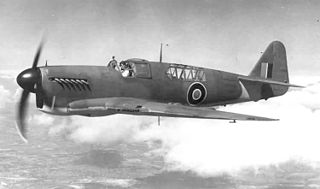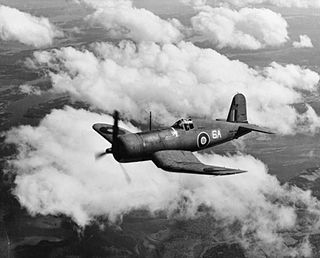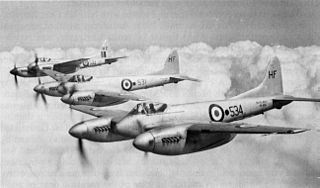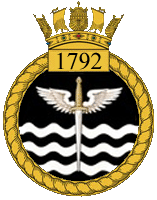
778 Naval Air Squadron was a Naval Air Squadron of the Royal Navy's Fleet Air Arm. During the Second World War the squadron was a Service Trials Unit (STU) initially based at HMS Daedalus, RNAS Lee-on-Solent, Hampshire, England before moving to HMS Condor, RNAS Arbroath, Angus, Scotland on 6 July 1940. The squadron tested all types of aircraft that could be used by the Royal Navy. Key to this was testing new types for deck landing on aircraft carriers. Such aircraft included various types of Supermarine Seafires, Grumman Hellcats, Grumman Martlets, Grumman Avengers, and Vought Corsairs. The squadron was reformed on 5 November 1951 with Douglas Skyraider AEW.1 but was disbanded on 7 July 1952 to form the basis of 849 Naval Air Squadron.

884 Naval Air Squadron was a Naval Air Squadron of the Royal Navy's Fleet Air Arm, which last disbanded in July 1943. It formed at HMS Merlin, RNAS Donibristle, as a Fleet Fighter squadron, in November 1941. The squadron assisted RAF Fighter Command, providing fighter cover and also participated other operations including the attempt to relieve the Siege of Malta and also the Allied invasion of French North Africa.

885 Naval Air Squadron was a Naval Air Squadron of the Royal Navy's Fleet Air Arm. First formed on 1 March 1941, the squadron served as a fighter squadron during the Second World War. It operated in the Mediterranean in 1942–43, where it took part in Operation Torch, the Anglo-American invasion of French North Africa, the Allied invasion of Sicily and the Allied invasion of Italy. In 1944 it took part in the Allied invasion of Normandy, spotting for Allied artillery bombardments and in 1945, was deployed as part of the British Pacific Fleet. It was abolished for the last time on 27 September 1945.

886 Naval Air Squadron was a Naval Air Squadron of the Royal Navy's Fleet Air Arm. It was formed at HMS Merlin, RNAS Donibristle, as a Fleet Fighter squadron during March 1942. The squadron was loaned to RAF Fighter Command during the summer of 1942, returning the Fleet Air Arm later on in the year. 1943 saw it participate in Operation Avalanche, part of the Allied invasion of Italy. The following year it was involved with operations over Normandy, spotting for the allied invasion of France from 6 to the end of June 1944, disbanding the following month.

887 Naval Air Squadron was a Naval Air Squadron of the Royal Navy's Fleet Air Arm, which last disbanded during March 1946. It was formed as a Fleet Fighter squadron in May 1942 at HMS Daedalus, RNAS, Lee-on-Solent. The squadron embarked in HMS Unicorn during 1943 for convoy escort duties and later in the year to cover the allied landings at Salerno, Italy. At the end of 1943 it formed part of the 24th Naval Fighter Wing. 1944 saw it embark in HMS Indefatigable and the squadron saw action in operations against the german battleship Tirpitz during early 1944 and then joined the British Pacific Fleet at the end of the year. It was part of the attacks on the oil refineries at Palembang at the start of 1945 and later in the year it was involved in sorties around Tokyo, as part of the 7th Carrier Air Group, before V-J Day.

1791 Naval Air Squadron was a Naval Air Squadron of the Royal Navy's Fleet Air Arm (FAA). It was formed on 15 March 1945 at HMS Daedalus, RNAS Lee-on-Solent as a Night Fighter squadron. It was equipped with Fairey Firefly NF.Mk I. The squadron joined HMS Puncher in June for deck landing practice but saw no action. Following V-J Day the squadron was disbanded on 23 September 1945 at HMS Ringtail, RNAS Burscough.

730 Naval Air Squadron was a Naval Air Squadron of the Royal Navy's Fleet Air Arm. It was active between 1944 and 1945 as a Communications Squadron. The squadron was formed and operated out of RNAS Abbotsinch from April to November 1944, by that point in time it operated four types of aircraft. It moved to RNAS Ayr and while there gained two more aircraft types. For the first three months of 1945 a detachment operated out of RNAS Machrihanish, however, the squadron remained at RNAS Ayr until disbanding in August 1945.

732 Naval Air Squadron was a Naval Air Squadron of the Royal Navy's Fleet Air Arm (FAA). It was initially formed in 1943 from a requirement for an Operational Training Unit for United States trained FAA pilots flying Vought Corsair fighter-bomber aircraft, at RN Air Section Brunswick, USNAS Brunswick, Maine, United States, and disbanded during 1944. In 1945 it was reformed for a brief period, as a Night Fighter Training Squadron, operating out of HMS Nighhawk, RNAS Drem, East Lothian, Scotland. Notably equipped with six Avro Anson 'flying classrooms', amongst other aircraft.

739 Naval Air Squadron was a Naval Air Squadron of the Royal Navy's Fleet Air Arm, which disbanded during 1950. It was formed as the Blind Approach Development Unit for the Fleet Air Arm, operating with Fairey Fulmar and Fairey Swordfish aircraft, at RNAS Lee-on-Solent, in 1942. Just under one year later the squadron moved to RNAS Worthy Down, in late 1943 and continued in the role. Roughly one year later the squadron moved again, relocating to RNAS Donibristle in late 1944, disbanding in 1945. It reformed in 1947 and was based at RNAS Culham, with a new role, as the Fleet Air Arm Photographic Trials and Development Unit.

746 Naval Air Squadron was a Naval Air Squadron of the Royal Navy's Fleet Air Arm which disbanded in January 1946. It formed initially as the Naval Night Fighter Interception Unit, in November 1942 at HMS Daedalus, RNAS Lee-on-Solent. It moved to R. N. Air Section Ford in December to join the RAF Fighter Interception Unit. The squadron came under the control of the Naval Fighter Direction Centre at HMS Heron, RNAS Yeovilton, in 1943 and was tasked with the development of tactics and analysis of the experiences of pilots from the carrier squadrons. It moved to RAF Wittering in May 1944, with a detachment at RAF Defford for radar development duties. In October the squadron returned to R. N. Air Section Ford and in January 1945, deployed 'A' flight to HMS Sparrowhawk, RNAS Hatston to provide ADDL, carrier deck landing training. 746 Naval Air Squadron became the Naval Night Fighter Development Squadron in May 1945, evaluating aircraft and their equipment, while detachments of pairs of aircraft were deployed aboard escort carriers after 'A' flight became an operational sub-unit.

768 Naval Air Squadron was a Naval Air Squadron of the Royal Navy's Fleet Air Arm (FAA). It last disbanded at HMS Gannet, RNAS Eglinton, Northern Ireland, in March 1949, having been formed as a Deck Landing Control Officer Training Squadron, in December 1948, to ensure one American-style signal trained DLCO could be located at every FAA station. It first formed as part of the Deck Landing Training School at HMS Condor, RNAS Arbroath, in January 1941, as a Deck Landing Training Squadron. Advanced training was in HMS Argus, for which a detachment was maintained at HMS Landrail, RNAS Machrihanish, where it wholly moved to in March 1943. September saw a move to RAF Heathfield, Ayr, followed by a further move to HMS Sanderling, RNAS Abbotsinch in January 1944. Training used escort carriers on the Firth of Clyde and a detachment was maintained at (Heathfield)Ayr throughout this period, with the squadron returning there in July 1945, at this time HMS Wagtail, RNAS Ayr. In August the squadron moved to HMS Corncrake, RNAS Ballyhalbert in Northern Ireland but then in October it joined up with the Deck Landing School at HMS Peewit, RNAS East Haven, Scotland, where it disbanded in April 1946.

770 Naval Air Squadron was a Naval Air Squadron of the Royal Navy's Fleet Air Arm. It last disbanded at HMS Nighthawk, RNAS Drem in October 1945. 770 Naval Air Squadron initially formed as a Deck Landing Training Squadron at HMS Daedalus, RNAS Lee-on-Solent, in November 1939. Embarked in HMS Argus, and operated from the aircraft carrier and Hyeres la Palyvestre in the south of France, until it disbanded in May 1940. It reformed at HMS Merlin, RNAS Donibristle, on New Year’s Day 1941, as a Fleet Requirements Unit out of 771 Naval Air Squadron’s 'X' Flight. It moved to HMS Jackdaw, RNAS Crail, in June 1941, then two and half years later it moved to HMS Jackdaw II, RNAS Dunino in January 1944, before finally moving to HMS Nighthawk in July.

772 Naval Air Squadron was a Naval Air Squadron of the Royal Navy's Fleet Air Arm which last disbanded during September 1995. 772 Naval Air Squadron formed as a Fleet Requirements Unit out of 'Y' Flight from 771 Naval Air Squadron at RNAS Lee-on-Solent in September 1939. While the headquarters remained there, floatplanes were operated out of RNAS Portland, however, mid 1940 saw the whole squadron move north to RNAS Campbeltown and roughly twelve months afterwards the short distance to RNAS Machrihanish. The unit moved to RNAS Ayr in July 1944 and became the Fleet Requirements Unit School. In January 1946 the squadron moved to RNAS Burscough in Lancashire, before moving to RNAS Anthorn in Cumberland, in May. It became the Northern Fleet Requirements Unit upon moving to RNAS Arbroath, in June 1947, but disbanded into 771 Naval Air Squadron in October. 772 Naval Air Squadron reformed as a Helicopter Support Squadron at RNAS Portland in September 1974. In September 1977 the squadron took over responsibility for a number of Ships' Flights of Royal Fleet Auxiliary ships. The squadron was used to reform 848 Naval Air Squadron for the Falklands Task Force in 1982, with the Ships' Flights absorbed into 847 Naval Air Squadron. In August 1982 it took on the Anti-Submarine Warfare Flight from 737 Naval Air Squadron and between 1983 - 1985 a Search and Rescue Flight operated out of RNAS Lee-on-Solent.

780 Naval Air Squadron was a Naval Air Squadron of the Royal Navy's Fleet Air Arm which last disbanded at HMS Seahawk, RNAS Culdrose in November 1949. 780 Naval Air Squadron formed at HMS Raven, RNAS Eastleigh as a Conversion Course Unit, in October 1939, to train experienced civilian pilots in naval flying. It moved to HMS Daedalus, RNAS Lee-on-Solent, in October 1940, and later, its role had changed to converting pilots to Fairey Barracuda aircraft. It spent a year at RNAS Charlton Horethorne, before returning to HMS Daedalus and disbanded, early 1945. In March 1946, the squadron reformed at HMS Godwit, RNAS Hinstock, as the Naval Advanced Flying School, to give flying instructors' courses, and later provided Instrument Flying Training. In December, the squadron moved to HMS Jackdaw, RNAS Crail, then in March 1947 moved to HMS Merlin, RNAS Donibristle, and in May to HMS Seahawk as the first resident unit.

783 Naval Air Squadron was a Naval Air Squadron of the Royal Navy's Fleet Air Arm which last disbanded in November 1949. 783 Naval Air Squadron was formed as an ASV Training Squadron at HMS Condor, RNAS Arbroath, Scotland, in January 1941. It operated a number of ‘flying classroom’ aircraft alongside other types. It operated in conjunction with the Naval Air Signals School (NASS) from March 1943. The squadron moved to HMS Daedalus, RNAS Lee-on-Solent, England, when the NASS moved south, also supporting the Flag Officer, Air, Home Communications Officer and from July 1948,it was part of the 51st Miscellaneous Air Group.

784 Naval Air Squadron was a Naval Air Squadron of the Royal Navy's Fleet Air Arm which last disbanded in the autumn of 1946. 784 NAS was a Night Fighter Training Squadron which formed at HMS Daedalus, RNAS Lee-on-Solent, Hampshire, in June 1942, moving to HMS Nighthawk, RNAS Drem, East Lothian, in October 1942. Squadron Personnel were also detached to the Naval Air Radio Installation Unit at RAF Christchurch, in 1943 and in the same year, a number of crews were attached to RAF night fighter squadrons, with two officers gained Distinguished Flying Crosses. In 1944, three squadron Flights were attached for service to each of 813, 825 and 835 Naval Air Squadrons, embarked in the escort carriers HMS Campania, HMS Vindex, and HMS Nairana respectively, on convoy protection duties. At the beginning of 1946 the squadron moved to Wales, operating out of HMS Goldcrest II, RNAS Brawdy.

787 Naval Air Squadron was a Naval Air Squadron of the Royal Navy's Fleet Air Arm which disbanded in January 1956. It formed in March 1941, at HMS Heron, RNAS Yeovilton, out of 804 Naval Air Squadron as a Fleet Fighter Development Unit. Almost every type of fighter was received by the squadron for testing and evaluation for naval use. A move to RAF Duxford in June 1941 saw it become the Naval Air Fighting Development Unit, attached to the Royal Air Force's Air Fighting Development Unit. The squadron undertook rocket projectile test, continuous development of fighter tactics and even helping Torpedo Bomber Reconnaissance squadrons in evading fighter attack. Post Second World War it continued its trials task and also undertook Rebecca radar trials and ASH, US-built air-to-surface-vessel radar trials.

790 Naval Air Squadron was a Naval Air Squadron of the Royal Navy's Fleet Air Arm which disbanded in November 1949 at RNAS Culdrose. It initially formed during 1941 as an Air Target Towing Unit, at HMS Landrail, RNAS Macrihanish, in Scotland, from elements of two other Fleet Air Arm squadrons, however, this only lasted for three months and the unit was disbanded, absorbed into 772 Naval Air Squadron. It reformed the following year, in July 1942, tasked as a Fighter Direction Training Unit, at RNAS Charlton Horethorne. It provided support for the Fighter Direction School and had short spells at RAF Culmhead and RNAS Zeals, before reloacting to RNAS Dale in Pembrokeshire, next to the new purpose built Air Direction School, HMS Harrier or RNADC Kete, in 1945. The squadron moved to HMS Seahawk in Cornwall during December 1947.

798 Naval Air Squadron was a Naval Air Squadron of the Royal Navy's Fleet Air Arm which disbanded in March 1946. It formed at RNAS Lee-on-Solent, in October 1943, to provide advanced conversion courses, it initially operated with various single and twin-engined aircraft. Twin-engined aircraft broke away to become 762 Naval Air Squadron during March 1944. It had a detachment at RNAS Stretton for operational training for new Fairey Barracuda squadrons, but returned to HMS Daedalus at the beginning of August. The unit’s role changed slightly during 1945, providing refresher training, including Fleet Air Arm ex-Prisoners of War at RNAS Halesworth. The squadron moved to RNAS Hinstock, although operated out of its satellite RNAS Peplow, during November 1945.

799 Naval Air Squadron was a Naval Air Squadron of the Royal Navy's Fleet Air Arm which last disbanded during August 1952. It initially formed as a Pool Squadron in South Africa during September 1943, sharing Fairey Albacore aircraft with 798 Naval Air Squadron and providing flying time for aircrew prior to front line squadron assignment, disbanding in June 1944. It reformed in July 1945 as a Flying Check and Conversion Refresher Squadron at HMS Daedalus, RNAS Lee-on-Solent. Made up of three distinct flights, two of those operated away from Lee-on-Solent with a flight at HMS Siskin, RNAS Gosport, giving junior officers air experience, and another flight at HMS Dipper providing Supermarine Sea Otter conversion training. By May 1948 the whole unit had moved to HMS Heron, RNAS Yeovilton. In 1951, 799 Naval Air Squadron relocated to RNAS Machrihanish.




















